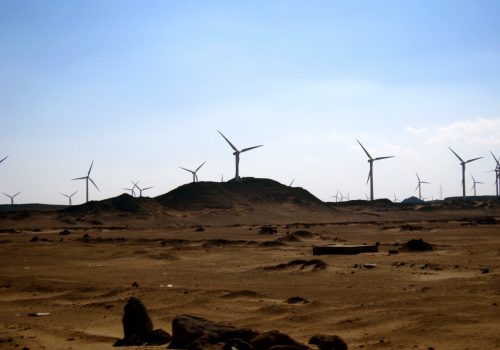Tensions from the US-China tech war have spilled over into green tech and climate efforts. Reports last month suggested Beijing has revised export/import guidelines to restrict the export of solar panel equipment (not the panels themselves). China produces and exports the most solar panels in the world and dominates the solar panel supply chain; the top ten suppliers of solar PV manufacturing equipment reside in China, and Chinese producers make up at least 80 percent of every step in the solar panel manufacturing process.
Notably, the move to restrict the export of equipment used to make key technology (here, solar panels) mirrors US actions to do the same with semiconductors. This mirroring tactic aligns with Beijing’s typical tit-for-tat approach when reacting to contentious events with the United States in recent years. As US-China geopolitical hostilities hit green tech sectors, intense competition brings both advantages and drawbacks for the industry.
The pretty…
Bottlenecks and vulnerabilities revealed by the COVID-19 pandemic have contributed to a global impulse to on-, re-, and friend-shore supply chains, resulting in increased investment in core technologies. The Biden administration has ramped up spending on semiconductors and STEM education, as well as batteries and their related components. Not only have American green tech sectors received greater policy prioritization, but they will also gain from new funding initiatives and from investments into STEM-related human capital and infrastructure. Moreover, a diversified tech supply chain would reduce geopolitical leverage of third-party countries, like China, in the medium to long term.
Additionally, recognizing supply chain dominance by countries of concern has the benefit of spurring research into and development of alternate technologies to reduce dependence on vulnerable supply chains. China’s supremacy in the production of silicon—the key critical mineral used in commercial solar panels currently—helps justify researching and commercializing other materials to produce solar panels, such as perovskites (though Chinese firms still play a major role in developing the technology) and US-led cadmium-telluride.
…and the ugly
China watchers have traditionally pointed to climate as an area for cooperation with China even during heightened tensions, but increasingly geopolitics have pushed environmental efforts towards competition. Secretary Raimondo’s November 30 speech on US-China relations mentioned competition twenty-six times, whereas cooperation appeared only six times. Democrats’ initial rush to decouple from China’s domestic clean energy industries temporarily strained relations with allies, while Republicans like Rep. Cathy McMorris Rodgers want to slow down the clean energy transition for fear of overreliance on China (and then focus on outcompeting China)—both strategies prioritize geopolitical competition over mitigating climate change. As Ilaria Marzocco noted, national security motivations for developing these technologies are eclipsing climate change needs.
Escalating even non-tech US-China tensions could threaten progress on climate efforts and green tech development. Conflict between the two, such as over a flashpoint like Taiwan, could distract these giants and force green tech advancements to take a back seat to conventional security priorities. Following Nancy Pelosi’s visit to Taiwan, China suspended the high-level US-China bilateral climate talks (though the talks resumed in November). Further straining the relationship could jeopardize green tech deployment and emissions reductions as the United States and China exchange blows.
Looking ahead: Pushing the pretty and mitigating the ugly
The Inflation Reduction Act (IRA) dedicates billions to funding clean energy initiatives. Prompt implementation of the different financing mechanisms will allow green tech companies to access the benefits of competition. Already, the Environmental Protection Agency has made progress; on February 14, it released guidelines for the IRA’s Greenhouse Gas Reduction Fund, of which $7 billion targets solar power deployment through the Zero-Emissions Technology Fund Competition. It expects to start accepting proposals this summer. Ensuring follow-through on implementation of US industrial policies will tackle the classic climate problem of failing to put commitments into practice and reduce the pain of supply chain reorientation.
Policymakers also need to guard against counterproductive fallout from tech tensions. The Biden administration has additional tech restrictions planned, buoyed by bipartisan support for countering China across multiple sectors. Beijing could respond in-kind with restrictions of its own going beyond solar panel equipment; China also dominates wind power supply chains, for example, and Beijing has taken issue with the Ford-CATL deal over concerns it could share core battery technology with the US company. Biden’s potential outbound investment executive order has been anticipated for several months, though, so it would not come as a surprise to Beijing. Clear communication with Chinese counterparts about US policy changes—when appropriate—can help dampen the reaction to competitive policies.
Meanwhile, like how Pelosi’s Taiwan visit suspended high-level US-China climate change talks for months, mitigating risks across other areas of the relationship will help insulate green tech from the negative effects of geopolitical competition. Sustaining bilateral dialogues and cooperating on other areas of mutual interest —for example, governance of AI-powered weapons, illicit fentanyl trade, nuclear threats from North Korea and Iran—can counter some of the spillover of rising tensions into the green tech sector.
China and the United States represent the top two individual emitters, together making up nearly 40 percent of global CO2 emissions. A healthy level of competition can catalyze innovation and uptake of clean energy and secures supply chains, but officials should take care not to escalate to where antagonism between the green tech powerhouses would slow down development and cut off markets around the world from accessing the best tools to combat emissions. How the two governments manage their relationship and their domestic policies affects economic outcomes for green tech companies as well as global climate security outcomes.
Jennifer Lee is a member of this year’s Women Leaders in Energy and Climate Fellowship at the Atlantic Council. She is an associate at the Scowcroft Group.
Meet the author
Related content
Learn more about the Global Energy Center

The Global Energy Center develops and promotes pragmatic and nonpartisan policy solutions designed to advance global energy security, enhance economic opportunity, and accelerate pathways to net-zero emissions.
Image: A microcontroller held above a printed circuit board (Vishnu Mohanan, Unsplash, Unsplash License) https://unsplash.com/license





